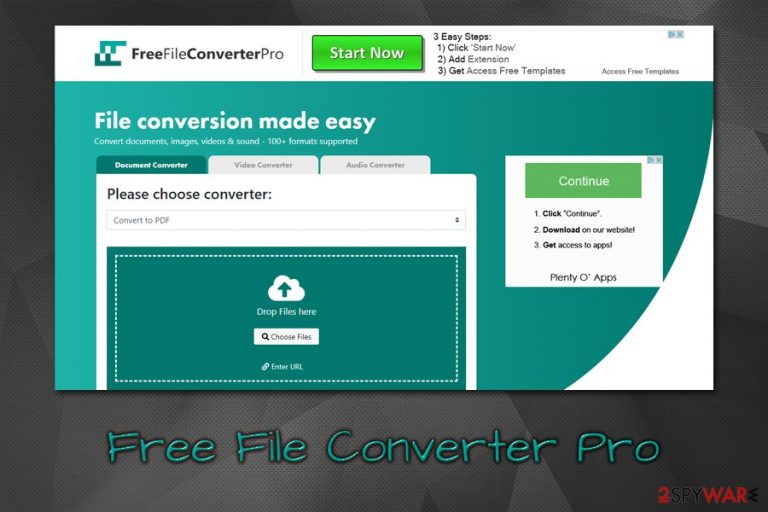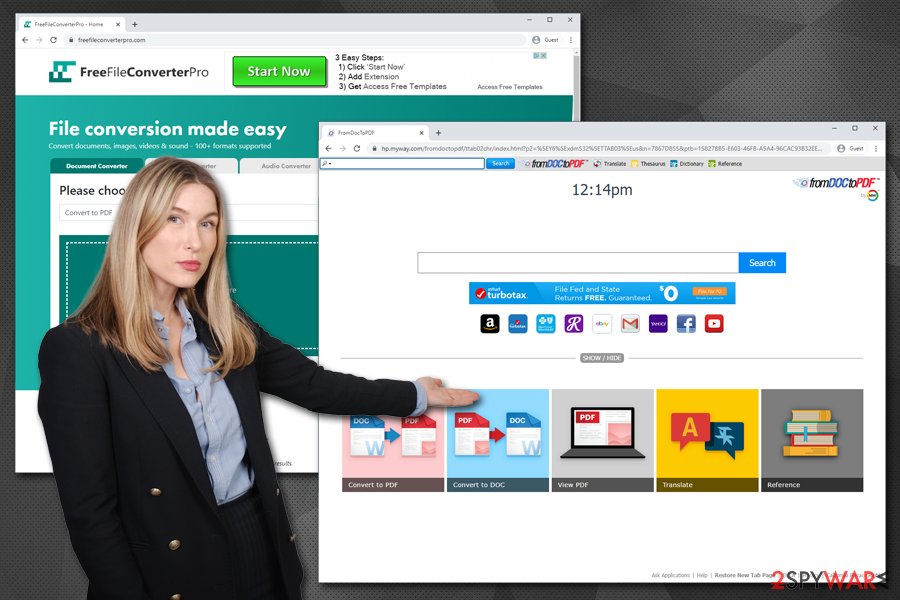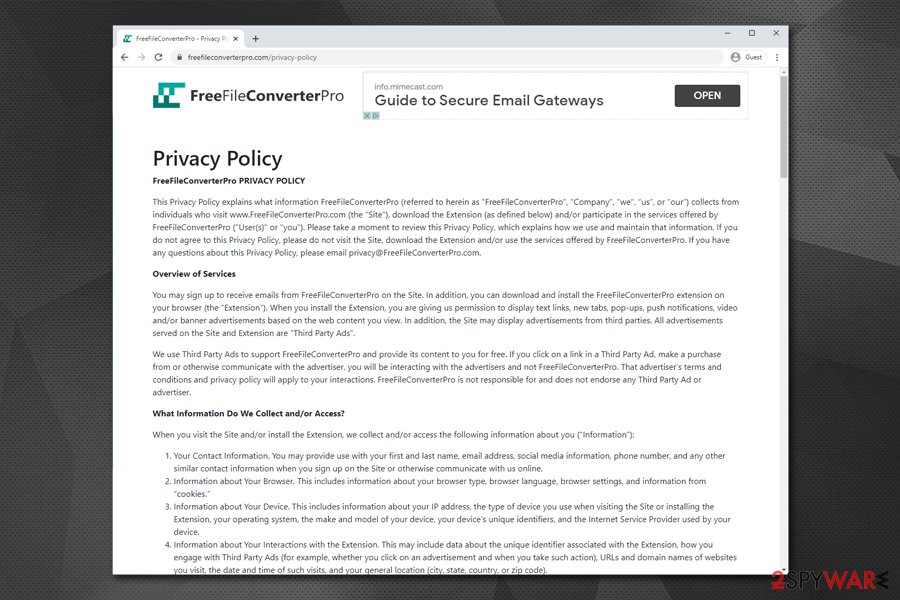Free File Converter Pro (Easy Removal Guide) - Free Instructions
Free File Converter Pro Removal Guide
What is Free File Converter Pro?
Free File Converter Pro – a potentially unwanted application that offers file conversion benefits but floods your browser with ads

Free File Converter Pro is a browser extension and an online service that offers free file conversion to PDF service. However, since the app delivers intrusive pop-ups, in-text links, notifications, redirects, and other types of ads, it is considered to be a potentially unwanted program, namely, adware.
Besides engaging in intrusive advertisement campaigns, Free File Converter Pro is also distributed via dubious ways, e.g., software bundles downloaded from third-party websites or fake update prompts. Besides, the app also gathers a variety of information about user web browser activities to serve targeted ads and profit from the activity financially.
| Name | Free File Converter Pro |
| Type | Adware |
| Distribution | The add-on can be downloaded on various third-party websites or delivered behind users' backs via software bundle packages. It can also be found via deceptive ads, such as fake updates or bogus pop-ups |
| Symptoms |
|
| Risks | Users might be subject of data tracking which is later shared with third-parties (privacy issues); some websites might result in the installation of other potentially unwanted applications; scams can lead to financial losses |
| Elimination | To get rid of the browser extension, access the settings of your web browser. If the unwanted ads do not stop, scan your machine with anti-malware and reset all the installed web browsers |
| System fix | Malware or adware infections can diminish the performance of your computer. Use FortectIntego to remediate your device and ensure that the virus damage is fixed |
Regardless if you are using Google Chrome, Mozilla Firefox, Safari, MS Edge, or another web browser – all of them can be affected by adware. Adware is mostly low-quality software that is designed to monetize users' clicks and/or ad campaigns that can diminish web browsing experience significantly. Hence, we recommend Free File Converter Pro removal.
Even though Free File Converter Pro is advertised as a useful tool that can convert over a hundred different file types to PDF format, it is important to note that it has many negative qualities that should not be ignored. As previously noticed, the app might be installed without permission – via freeware software packages.
Thus, if you noticed that an extension had been installed on your web browser, it is highly likely that it got in along with programs you downloaded from third-party websites. Precisely due to this reason, many users can refer to the app as Free File Converter Pro virus, although the term is not entirely correct.
In some cases, adware like Free File Converter Pro might attempt to disguise its presence on the computer/browser. For example, most extensions are immediately visible on the main bar of the browser. The one that tries to avoid being detected might not be visible, hence preventing easy Free File Converter Pro removal.
Even if the app managed to slip in vi deceptive methods, its presence could be often noticed at some point. Redirects, pop-up ads, surveys, push notifications, and other unwanted activity often plagues browsers that are infected with adware, and Free File Converter Pro is not an exception. In some cases, clicks made anywhere on the browser window might initiate redirects to potentially dangerous sites, where users can be tricked into downloading malware or spend money on useless services.

Besides, Free File Converter Pro ads are not the only issue that should cause concerns. When reading Privacy Policy that is provided on the official website of the app (although it cannot be downloaded from there – a good indication that the PUP is spread via software bundles), it is clearly stated that cookies, scrips, web beacons,[1] and other technologies are used to gather information about users:
We use “cookies”, scripts, web beacons, and/or other similar technology to collect, directly or indirectly, Information about you, which are commonly used on the Internet.
Gathered data includes browser information, installed extension list, OS data, clicks on ads, visited websites, and more. Nonetheless, Free File Converter Pro also collects some personal data, including the IP address and contact information (if such is provided). Harvested details are later shared with third-parties, affiliates, partners, and other sources.
All in all, we recommend you remove Free File Converter Pro from your system and rely on more trustworthy apps. If you are struggling with the process, check the instructions we provide below. Other recommendations include scanning the computer with anti-malware and repair software (such as FortectIntego), as well as resetting web browsers if the unwanted activities do not stop.
Learn how to differentiate reputable apps from dubious ones
There are millions of apps[2] available to download for users' disposal. A vast majority of those programs are allegedly free – all users have to do is download and install them. However, it is important to understand that, unless the app is open-source, it is never actually free per se, as it uses other monetization methods for the purpose – advertisements. While there is nothing wrong with this type of financing, some apps use less than fair methods to break into the market.
Most commonly, potentially unwanted programs are downloaded off of third-party freeware websites, with the help of a technique called software bundling. Lack of attention when installing these apps is a perfect example of why this method is so effective, and many end up with software that they never intended to install in the first place. Unfortunately, some of these programs might be PUPs or even malware.
Thus, you should learn how to avoid online dangers by being careful when using the internet. Security researchers from novirus.uk[3] provide the following tips:
- Before installing a new app, always read up on it online – check reviews, forum posts and other user feedback;
- Download apps from official sources if possible;
- When prompted, always opt for Advanced/Custom installation mode instead of recommended one;
- Watch out for pre-ticked boxes, fine print text, misleading offers, and other tricks;
- Ensure that Privacy Policy and Terms of Service are provided during the installation;
- Install powerful security software that can detect both malware and PUPs.

A secure way to delete Free File Converter Pro and other PUPs from your computer
Potentially unwanted programs clutter your computer, slow it down, and can also compromise safe online browsing. For those reasons, remove Free File Converter Pro and other PUPs that could be installed on your machine immediately. You can do that either manually or automatically:
- Scan your computer with anti-malware (note: not all AVs can detect all potentially unwanted programs);
- Use our manual instructions we provide below.
When it comes to Free File Converter Pro removal, you should be able to uninstall the app by right-clicking on the extension. However, keep in mind that you might have other unwanted programs installed on your device, which can cause ads and redirects. Thus, a scan with a powerful anti-malware is always recommended. In case that does not help, you should reset all the installed web browsers to set their settings to default.
You may remove virus damage with a help of FortectIntego. SpyHunter 5Combo Cleaner and Malwarebytes are recommended to detect potentially unwanted programs and viruses with all their files and registry entries that are related to them.
Getting rid of Free File Converter Pro. Follow these steps
Uninstall from Windows
Get rid of unwanted applications via the Control Panel on Windows devices:
Instructions for Windows 10/8 machines:
- Enter Control Panel into Windows search box and hit Enter or click on the search result.
- Under Programs, select Uninstall a program.

- From the list, find the entry of the suspicious program.
- Right-click on the application and select Uninstall.
- If User Account Control shows up, click Yes.
- Wait till uninstallation process is complete and click OK.

If you are Windows 7/XP user, proceed with the following instructions:
- Click on Windows Start > Control Panel located on the right pane (if you are Windows XP user, click on Add/Remove Programs).
- In Control Panel, select Programs > Uninstall a program.

- Pick the unwanted application by clicking on it once.
- At the top, click Uninstall/Change.
- In the confirmation prompt, pick Yes.
- Click OK once the removal process is finished.
Delete from macOS
If you are using a Mac and are suffering from ads, follow these steps:
Remove items from Applications folder:
- From the menu bar, select Go > Applications.
- In the Applications folder, look for all related entries.
- Click on the app and drag it to Trash (or right-click and pick Move to Trash)

To fully remove an unwanted app, you need to access Application Support, LaunchAgents, and LaunchDaemons folders and delete relevant files:
- Select Go > Go to Folder.
- Enter /Library/Application Support and click Go or press Enter.
- In the Application Support folder, look for any dubious entries and then delete them.
- Now enter /Library/LaunchAgents and /Library/LaunchDaemons folders the same way and terminate all the related .plist files.

Remove from Microsoft Edge
Delete unwanted extensions from MS Edge:
- Select Menu (three horizontal dots at the top-right of the browser window) and pick Extensions.
- From the list, pick the extension and click on the Gear icon.
- Click on Uninstall at the bottom.

Clear cookies and other browser data:
- Click on the Menu (three horizontal dots at the top-right of the browser window) and select Privacy & security.
- Under Clear browsing data, pick Choose what to clear.
- Select everything (apart from passwords, although you might want to include Media licenses as well, if applicable) and click on Clear.

Restore new tab and homepage settings:
- Click the menu icon and choose Settings.
- Then find On startup section.
- Click Disable if you found any suspicious domain.
Reset MS Edge if the above steps did not work:
- Press on Ctrl + Shift + Esc to open Task Manager.
- Click on More details arrow at the bottom of the window.
- Select Details tab.
- Now scroll down and locate every entry with Microsoft Edge name in it. Right-click on each of them and select End Task to stop MS Edge from running.

If this solution failed to help you, you need to use an advanced Edge reset method. Note that you need to backup your data before proceeding.
- Find the following folder on your computer: C:\\Users\\%username%\\AppData\\Local\\Packages\\Microsoft.MicrosoftEdge_8wekyb3d8bbwe.
- Press Ctrl + A on your keyboard to select all folders.
- Right-click on them and pick Delete

- Now right-click on the Start button and pick Windows PowerShell (Admin).
- When the new window opens, copy and paste the following command, and then press Enter:
Get-AppXPackage -AllUsers -Name Microsoft.MicrosoftEdge | Foreach {Add-AppxPackage -DisableDevelopmentMode -Register “$($_.InstallLocation)\\AppXManifest.xml” -Verbose

Instructions for Chromium-based Edge
Delete extensions from MS Edge (Chromium):
- Open Edge and click select Settings > Extensions.
- Delete unwanted extensions by clicking Remove.

Clear cache and site data:
- Click on Menu and go to Settings.
- Select Privacy, search and services.
- Under Clear browsing data, pick Choose what to clear.
- Under Time range, pick All time.
- Select Clear now.

Reset Chromium-based MS Edge:
- Click on Menu and select Settings.
- On the left side, pick Reset settings.
- Select Restore settings to their default values.
- Confirm with Reset.

Remove from Mozilla Firefox (FF)
Remove dangerous extensions:
- Open Mozilla Firefox browser and click on the Menu (three horizontal lines at the top-right of the window).
- Select Add-ons.
- In here, select unwanted plugin and click Remove.

Reset the homepage:
- Click three horizontal lines at the top right corner to open the menu.
- Choose Options.
- Under Home options, enter your preferred site that will open every time you newly open the Mozilla Firefox.
Clear cookies and site data:
- Click Menu and pick Settings.
- Go to Privacy & Security section.
- Scroll down to locate Cookies and Site Data.
- Click on Clear Data…
- Select Cookies and Site Data, as well as Cached Web Content and press Clear.

Reset Mozilla Firefox
If clearing the browser as explained above did not help, reset Mozilla Firefox:
- Open Mozilla Firefox browser and click the Menu.
- Go to Help and then choose Troubleshooting Information.

- Under Give Firefox a tune up section, click on Refresh Firefox…
- Once the pop-up shows up, confirm the action by pressing on Refresh Firefox.

Remove from Google Chrome
Delete malicious extensions from Google Chrome:
- Open Google Chrome, click on the Menu (three vertical dots at the top-right corner) and select More tools > Extensions.
- In the newly opened window, you will see all the installed extensions. Uninstall all the suspicious plugins that might be related to the unwanted program by clicking Remove.

Clear cache and web data from Chrome:
- Click on Menu and pick Settings.
- Under Privacy and security, select Clear browsing data.
- Select Browsing history, Cookies and other site data, as well as Cached images and files.
- Click Clear data.

Change your homepage:
- Click menu and choose Settings.
- Look for a suspicious site in the On startup section.
- Click on Open a specific or set of pages and click on three dots to find the Remove option.
Reset Google Chrome:
If the previous methods did not help you, reset Google Chrome to eliminate all the unwanted components:
- Click on Menu and select Settings.
- In the Settings, scroll down and click Advanced.
- Scroll down and locate Reset and clean up section.
- Now click Restore settings to their original defaults.
- Confirm with Reset settings.

Delete from Safari
In case Free File Converter Pro cannot be eliminated in a simple way, reset your Safari as explained below:
Remove unwanted extensions from Safari:
- Click Safari > Preferences…
- In the new window, pick Extensions.
- Select the unwanted extension and select Uninstall.

Clear cookies and other website data from Safari:
- Click Safari > Clear History…
- From the drop-down menu under Clear, pick all history.
- Confirm with Clear History.

Reset Safari if the above-mentioned steps did not help you:
- Click Safari > Preferences…
- Go to Advanced tab.
- Tick the Show Develop menu in menu bar.
- From the menu bar, click Develop, and then select Empty Caches.

After uninstalling this potentially unwanted program (PUP) and fixing each of your web browsers, we recommend you to scan your PC system with a reputable anti-spyware. This will help you to get rid of Free File Converter Pro registry traces and will also identify related parasites or possible malware infections on your computer. For that you can use our top-rated malware remover: FortectIntego, SpyHunter 5Combo Cleaner or Malwarebytes.
How to prevent from getting adware
Access your website securely from any location
When you work on the domain, site, blog, or different project that requires constant management, content creation, or coding, you may need to connect to the server and content management service more often. The best solution for creating a tighter network could be a dedicated/fixed IP address.
If you make your IP address static and set to your device, you can connect to the CMS from any location and do not create any additional issues for the server or network manager that needs to monitor connections and activities. VPN software providers like Private Internet Access can help you with such settings and offer the option to control the online reputation and manage projects easily from any part of the world.
Recover files after data-affecting malware attacks
While much of the data can be accidentally deleted due to various reasons, malware is one of the main culprits that can cause loss of pictures, documents, videos, and other important files. More serious malware infections lead to significant data loss when your documents, system files, and images get encrypted. In particular, ransomware is is a type of malware that focuses on such functions, so your files become useless without an ability to access them.
Even though there is little to no possibility to recover after file-locking threats, some applications have features for data recovery in the system. In some cases, Data Recovery Pro can also help to recover at least some portion of your data after data-locking virus infection or general cyber infection.
- ^ Vangie Beal. Web beacon. Webopedia. Online Tech Dictionary for Students, Educators and IT Professionals.
- ^ John Koetsier. There Are Now 8.9 Million Mobile Apps, And China Is 40% Of Mobile App Spending. Forbes. Business, investing, technology, entrepreneurship, leadership, and lifestyle.
- ^ Novirus.uk. Novirus.uk. Security news and malware insights.
